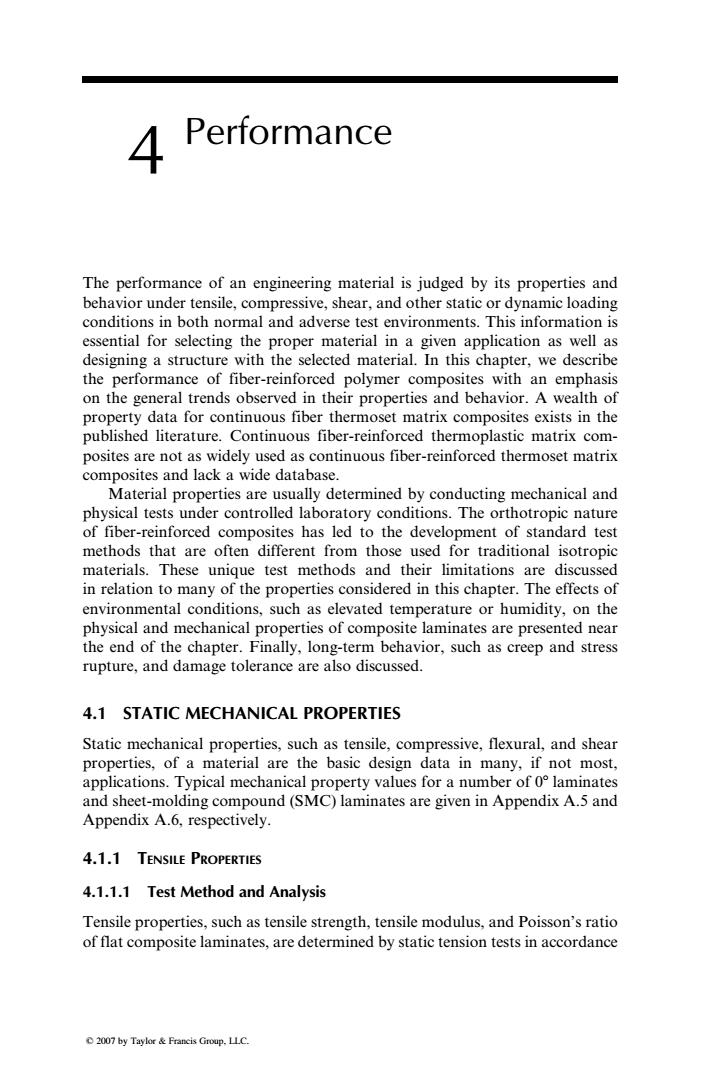正在加载图片...

4 Performance The performance of an engineering material is judged by its properties and behavior under tensile,compressive,shear,and other static or dynamic loading conditions in both normal and adverse test environments.This information is essential for selecting the proper material in a given application as well as designing a structure with the selected material.In this chapter,we describe the performance of fiber-reinforced polymer composites with an emphasis on the general trends observed in their properties and behavior.A wealth of property data for continuous fiber thermoset matrix composites exists in the published literature.Continuous fiber-reinforced thermoplastic matrix com- posites are not as widely used as continuous fiber-reinforced thermoset matrix composites and lack a wide database. Material properties are usually determined by conducting mechanical and physical tests under controlled laboratory conditions.The orthotropic nature of fiber-reinforced composites has led to the development of standard test methods that are often different from those used for traditional isotropic materials.These unique test methods and their limitations are discussed in relation to many of the properties considered in this chapter.The effects of environmental conditions,such as elevated temperature or humidity,on the physical and mechanical properties of composite laminates are presented near the end of the chapter.Finally,long-term behavior,such as creep and stress rupture,and damage tolerance are also discussed. 4.1 STATIC MECHANICAL PROPERTIES Static mechanical properties,such as tensile,compressive,flexural,and shear properties,of a material are the basic design data in many,if not most, applications.Typical mechanical property values for a number of 0 laminates and sheet-molding compound(SMC)laminates are given in Appendix A.5 and Appendix A.6,respectively. 4.1.1 TENSILE PROPERTIES 4.1.1.1 Test Method and Analysis Tensile properties,such as tensile strength,tensile modulus,and Poisson's ratio of flat composite laminates,are determined by static tension tests in accordance 2007 by Taylor Francis Group.LLC.4 Performance The performance of an engineering material is judged by its properties and behavior under tensile, compressive, shear, and other static or dynamic loading conditions in both normal and adverse test environments. This information is essential for selecting the proper material in a given application as well as designing a structure with the selected material. In this chapter, we describe the performance of fiber-reinforced polymer composites with an emphasis on the general trends observed in their properties and behavior. A wealth of property data for continuous fiber thermoset matrix composites exists in the published literature. Continuous fiber-reinforced thermoplastic matrix composites are not as widely used as continuous fiber-reinforced thermoset matrix composites and lack a wide database. Material properties are usually determined by conducting mechanical and physical tests under controlled laboratory conditions. The orthotropic nature of fiber-reinforced composites has led to the development of standard test methods that are often different from those used for traditional isotropic materials. These unique test methods and their limitations are discussed in relation to many of the properties considered in this chapter. The effects of environmental conditions, such as elevated temperature or humidity, on the physical and mechanical properties of composite laminates are presented near the end of the chapter. Finally, long-term behavior, such as creep and stress rupture, and damage tolerance are also discussed. 4.1 STATIC MECHANICAL PROPERTIES Static mechanical properties, such as tensile, compressive, flexural, and shear properties, of a material are the basic design data in many, if not most, applications. Typical mechanical property values for a number of 08 laminates and sheet-molding compound (SMC) laminates are given in Appendix A.5 and Appendix A.6, respectively. 4.1.1 TENSILE PROPERTIES 4.1.1.1 Test Method and Analysis Tensile properties, such as tensile strength, tensile modulus, and Poisson’s ratio of flat composite laminates, are determined by static tension tests in accordance 2007 by Taylor & Francis Group, LLC